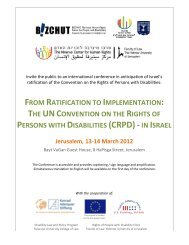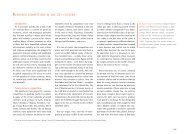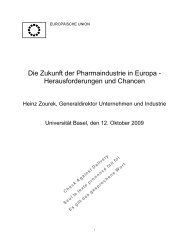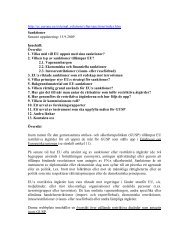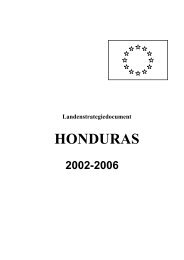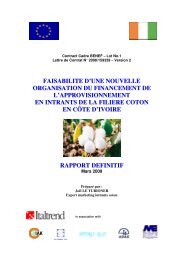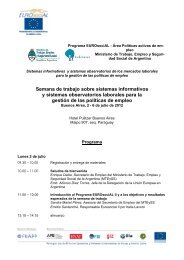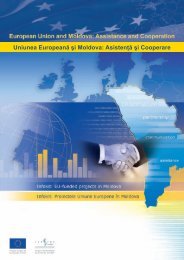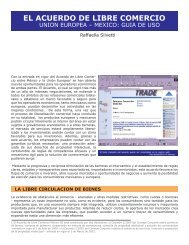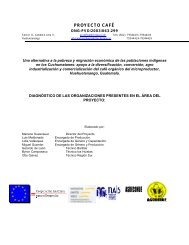Vision Group Report: Invigorating the Indonesia-EU Partnership
Vision Group Report: Invigorating the Indonesia-EU Partnership
Vision Group Report: Invigorating the Indonesia-EU Partnership
Create successful ePaper yourself
Turn your PDF publications into a flip-book with our unique Google optimized e-Paper software.
also far more open (and committed) than <strong>the</strong> GATS has<br />
been able to accomplish until today. The <strong>EU</strong> regards market<br />
access and a solid anchoring into ‘globalized value chains’<br />
via IPRs, investment liberalisation and legal certainty for<br />
its businesses as crucial for its long-run economic growth<br />
rate.<br />
The 2010 strategy says: “We should make good use of<br />
fast-growing regional trade in East Asia and pursue our<br />
strategic economic interests in that region, inter alia, by<br />
linking into <strong>the</strong> rapidly growing network of free trade<br />
areas …We will <strong>the</strong>refore seek to expand and conclude<br />
bilateral negotiations with ASEAN countries, beginning<br />
with Malaysia and Vietnam, and to deepen our trade and<br />
investment relations with <strong>the</strong> Far East” 2 . A new ambition<br />
in terms of <strong>the</strong> proposed <strong>Indonesia</strong>-<strong>EU</strong> CEPA fits exactly to<br />
this strategy.<br />
Third, a simple and static simulation model for bilateral<br />
liberalisation in goods and services shows positive<br />
economic gains for both economies. The positive growth<br />
impact of a comprehensive agreement is fur<strong>the</strong>r enhanced<br />
by facilitation of investment in <strong>the</strong> form of FDI and even<br />
more as capacity building and complementary facilitation<br />
measures improve <strong>the</strong> capability of <strong>Indonesia</strong> to exploit<br />
<strong>the</strong>se mutual market openings:<br />
Given a simple static simulation, results show that: (a)<br />
immediate bilateral tariff elimination would increase<br />
<strong>Indonesia</strong>n and <strong>EU</strong> welfare modestly – for <strong>Indonesia</strong> by<br />
0.1 % of GDP, for <strong>the</strong> <strong>EU</strong> less; (b) only a limited number of<br />
sectors in <strong>Indonesia</strong> might risk some adjustment pressure<br />
and <strong>the</strong> likely causes of lack of competitiveness point<br />
to limited availability of technology, lack of capacity and<br />
inadequate infrastructure – all of which suggests a strong<br />
case for enhanced economic cooperation with <strong>the</strong> <strong>EU</strong> to<br />
help increase competitiveness<br />
However, given a dynamic simulation that better reflects<br />
realistic potential impact of a comprehensive agreement,<br />
with FDI coming into <strong>Indonesia</strong> helping local capital<br />
accumulation, <strong>the</strong> results <strong>the</strong>n show: (a) that long–run<br />
gains would be 1.3 % of GDP for <strong>Indonesia</strong> (some € 6.3<br />
billion in 2010 GDP terms); (b) that <strong>Indonesia</strong>n exports<br />
would increase by US$ 9.8 billion in <strong>the</strong> longer run,<br />
especially for light industries and transport equipment,<br />
and that <strong>the</strong> <strong>Indonesia</strong>n trade balance would increase by<br />
some US$ 2 billion ; (e) <strong>the</strong> overall rise in <strong>Indonesia</strong>n wages<br />
2 See COM (2010) 612 of 9 November 2010, Trade, Growth and<br />
World Affairs, p. 10<br />
would amount to 1.5%, with a positive impact on poverty<br />
alleviation as well 3 .<br />
Yet larger gains could be reaped if <strong>the</strong> <strong>Indonesia</strong>n economy<br />
can be stimulated by opportunities and incoming FDI,<br />
accompanied by expected improvements in infrastructure,<br />
allowing <strong>Indonesia</strong> to benefit from its dynamic comparative<br />
advantages and from higher value-added locally to support<br />
sustained higher incomes per capita. Even though <strong>the</strong> <strong>EU</strong><br />
today is <strong>Indonesia</strong>’s second largest source of investment,<br />
it still represents only 1.6% of <strong>EU</strong> investment in Asia.<br />
Clearly would conditions permit <strong>the</strong> investment levels from<br />
<strong>the</strong> <strong>EU</strong> could be far greater as European companies would<br />
favorably consider <strong>Indonesia</strong> more often (than <strong>the</strong>y do<br />
today) when setting up or re-arranging parts of <strong>the</strong>ir value<br />
chains in Asia.<br />
Fourth, an additional attraction of an “invigorating”<br />
of <strong>the</strong> <strong>Indonesia</strong>n-<strong>EU</strong> economic relationship is that<br />
<strong>the</strong> complementarity between <strong>EU</strong> and <strong>Indonesia</strong> is<br />
rooted deeply in differences in physical endowments<br />
and resources, and demographics. This fundamental<br />
complementarity facilitates that <strong>the</strong> benefits of a CEPA<br />
be shared more equitably and lessens <strong>the</strong> probability of<br />
disruptive trade imbalances arising, as may have been<br />
seen with o<strong>the</strong>r agreements signed by <strong>Indonesia</strong> recently.<br />
Moreover, <strong>the</strong> economic complementarities of <strong>the</strong> partners<br />
have <strong>the</strong> effect of significantly reducing – or, in many<br />
sectors, avoiding - adjustment costs falling on workers or<br />
SMEs. Although from an economy-wide point of view such<br />
adjustments can be justified as a necessary (but temporary)<br />
cost incurred when seizing new opportunities by both<br />
sides, <strong>the</strong> actual benefit/cost ratios envisaged given <strong>the</strong><br />
complementarity of <strong>the</strong> partner economies is likely to be<br />
far more favorable.<br />
CEPA-stimulated FDI inflows from <strong>the</strong> <strong>EU</strong> are likely<br />
to be directed in <strong>the</strong> short-run at tapping existing<br />
complementarities more fully. However, <strong>the</strong>y will also help<br />
diversify <strong>Indonesia</strong>’s industries and exports, producing<br />
higher value-added and improved technology in <strong>Indonesia</strong>’s<br />
key sectors as competencies improve among <strong>Indonesia</strong>n<br />
workers and business people and <strong>the</strong> investment policy<br />
environment continues to improve.<br />
3 See annex 2 for a more detailed analysis<br />
17




